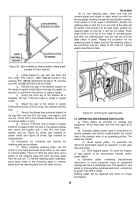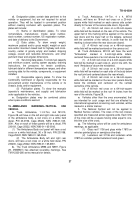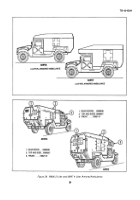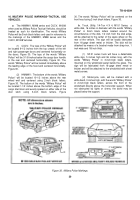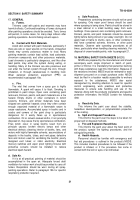TB-43-0209 - Page 41 of 406
TB 43-0209
27. PREPARATION FOR PATTERN PAINTING
a.
The first step in pattern painting an item is to
thoroughly clean the surfaces to be painted. Applying
paint to anything less than a totally clean surface will
result in rapid peeling, cracking, and scaling of the new
coating.
NOTE
Check for cleanliness by the red
litmus or water break test before
applying CARC materials.
b.
Clean with detergent or solvent and thoroughly
rinse or steam clean to insure a totally clean surface
suitable for a durable coating. Grease, oil, dirt, markings,
and all loose and scaling paint must be removed.
Reference TM 43-0139.
c
.
Sanding of rough areas to remove the oxidized
surface from the old paint will also make the new paint
job look better and last longer. If bare metal is exposed
following sanding and cleaning, apply an epoxy primer to
the bare metal. The primer should be allowed to
thoroughly dry before CARC is applied.
d.
All glass, grease fittings, and items which can be
damaged by paint must be masked with masking tape
and/or paper.
NOTE
Grease should not be used for
masking because it can easily be
smeared onto other parts of the
equipment and prevent the paint from
sticking.
e.
The following is a list of items needed for pattern
painting:
(1)
Vehicle or other item of equipment.
(2)
Pattern-painting design for the specific
vehicle or other item of equipment.
(3)
Spray guns, if applicable.
(4)
Paint.
(5)
Thinners as required by TM 43-0139.
(6)
Mixing buckets.
(7)
Paint brushes, 1/2-inch, 1-inch, and 3-inch.
(8)
Paddles or sticks to mix paint.
(9)
Painters’ masks.
(10) Masking tape for masking small items.
(11) Brown
(kraft)
paper
for
masking
windshields, etc.
(12) Detergent to clean vehicles.
(13) Chalk for marking paint areas.
(14) Steel wool or sandpaper.
(15) Rags.
(16) Compressed air source, if applicable.
.
(17) Water separators and fittings with pressure
gage.
(18) Wrenches for spray guns, if applicable.
28. OUTLINING THE CAMOUFLAGE PATTERN ON
THE VEHICLE
a.
The black bands, located at the visual center of
each side in a pattern, are the key to the three-color
camouflage systems.
These bands must be in the correct place and must be
the correct width.
b
.
To ensure correct placement and width, each
pattern has between 10 and 25 critical reference points.
Critical reference points are based on fixed features on
the item and are reflected on the vehicle patterns in
Section VIII.
c.
All dimensions are listed in inches
d.
All dimensional tolerances are limited to +1.00
inch.
e
.
The right side view is the primary view of the
CPP drawings.
f.
In the top view of the paint pattern drawings, the
horizontal is established as being from front-to-back
along the longest dimension of the item.
g.
The edge of the band must be within one inch of
a critical-location reference point and the pattern must be
no more than one inch wider or narrower than stated at a
critical-width reference point The rest of the item will
mirror the camouflage pattern as much as possible.
h
.
Inspections will only be measured at reference
points and will evaluate the overall effect at 50 feet. In
addition, overspray which can be discerned at 50 feet will
be considered sloppy painting and will be corrected.
i.
Outlining the camouflage pattern can be done in
a variety of ways. Successful methods include freehand,
template, wire-form and viewgraph, Figure 32.
36
Back to Top

